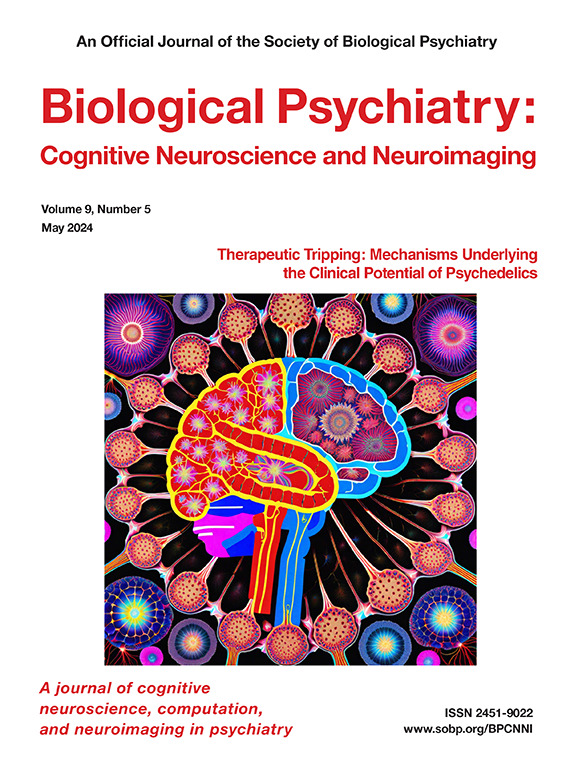冥想的神经现象学方法及其与临床研究的相关性概述。
IF 5.7
2区 医学
Q1 NEUROSCIENCES
Biological Psychiatry-Cognitive Neuroscience and Neuroimaging
Pub Date : 2025-04-01
DOI:10.1016/j.bpsc.2024.11.008
引用次数: 0
摘要
在意识研究、当代精神病学和神经计算领域,人们对认真对待现象学重新产生了兴趣。由瓦雷拉(1996 年)开创的神经现象学研究项目,在现象学和冥想实践的启发下,采用第一人称方法对主观体验进行了严格研究。本综述探讨了神经现象学方法的最新进展,特别是其在冥想实践中的应用和潜在的临床研究转化。我们首先研究创新的多维现象学评估工具,这些工具旨在捕捉冥想过程中体验内容和意识结构的微妙、动态变化。这些经验取样方法为冥想练习和闭关的机制和动态轨迹提供了新的视角。其次,我们强调神经现象学的实证研究如何利用经验丰富的冥想者的专业知识来解构厌恶和自我相关过程,提供详细的第一人称报告,指导研究人员识别与疼痛调节、自我解脱和接受死亡相关的新型行为和神经动态标记。最后,我们将讨论一个最新的框架--深度计算神经现象学,它更新了神经现象学的理论抱负,将现象学 "自然化"(瓦雷拉,1997 年)。该框架采用了深度参数主动推理的形式主义,其中参数深度指的是生成模型的一种属性,它可以形成对自身建模过程参数的信念。总之,这些以严格的第一人称调查为核心的方法论创新,凸显了现象学、计算和神经生理学领域之间在认识论上有益的相互制约的潜力。这将有助于综合理解精神疾病的生物学基础、治疗方法及其与患者生活体验的紧密联系。本文章由计算机程序翻译,如有差异,请以英文原文为准。
An Overview of Neurophenomenological Approaches to Meditation and Their Relevance to Clinical Research
There is a renewed interest in taking phenomenology seriously in consciousness research, contemporary psychiatry, and neurocomputation. The neurophenomenology research program, pioneered by Varela, rigorously examines subjective experience using first-person methodologies, inspired by phenomenology and contemplative practices. This review explores recent advancements in neurophenomenological approaches, particularly their application to meditation practices and potential clinical research translations. First, we examine innovative multidimensional phenomenological assessment tools designed to capture subtle, dynamic shifts in experiential content and structures of consciousness during meditation. These experience sampling approaches enable shedding new light on the mechanisms and dynamic trajectories of meditation practice and retreat. Second, we highlight how empirical studies in neurophenomenology leverage the expertise of experienced meditators to deconstruct aversive and self-related processes, providing detailed first-person reports that guide researchers in identifying novel behavioral and neurodynamic markers associated with pain regulation, self-dissolution, and acceptance of mortality. Finally, we discuss a recent framework, deep computational neurophenomenology, that updates the theoretical ambitions of neurophenomenology to naturalize phenomenology. This framework uses the formalism of deep parametric active inference, where parametric depth refers to a property of generative models that can form beliefs about the parameters of their own modeling process. Collectively, these methodological innovations, centered around rigorous first-person investigation, highlight the potential of epistemologically beneficial mutual constraints among phenomenological, computational, and neurophysiological domains. This could contribute to an integrated understanding of the biological basis of mental illness, its treatment, and its tight connections to the lived experience of the patient.
求助全文
通过发布文献求助,成功后即可免费获取论文全文。
去求助
来源期刊

Biological Psychiatry-Cognitive Neuroscience and Neuroimaging
Neuroscience-Biological Psychiatry
CiteScore
10.40
自引率
1.70%
发文量
247
审稿时长
30 days
期刊介绍:
Biological Psychiatry: Cognitive Neuroscience and Neuroimaging is an official journal of the Society for Biological Psychiatry, whose purpose is to promote excellence in scientific research and education in fields that investigate the nature, causes, mechanisms, and treatments of disorders of thought, emotion, or behavior. In accord with this mission, this peer-reviewed, rapid-publication, international journal focuses on studies using the tools and constructs of cognitive neuroscience, including the full range of non-invasive neuroimaging and human extra- and intracranial physiological recording methodologies. It publishes both basic and clinical studies, including those that incorporate genetic data, pharmacological challenges, and computational modeling approaches. The journal publishes novel results of original research which represent an important new lead or significant impact on the field. Reviews and commentaries that focus on topics of current research and interest are also encouraged.
 求助内容:
求助内容: 应助结果提醒方式:
应助结果提醒方式:


